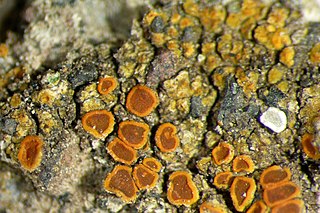
Parmelia is a genus of medium to large foliose lichens. It has a global distribution, extending from the Arctic to the Antarctic continent but concentrated in temperate regions. There are about 40 species in Parmelia. In recent decades, the once large genus Parmelia has been divided into a number of smaller genera according to thallus morphology and phylogenetic relatedness.

The Parmeliaceae is a large and diverse family of Lecanoromycetes. With over 2700 species in 71 genera, it is the largest family of lichen-forming fungi. The most speciose genera in the family are the well-known groups: Xanthoparmelia, Usnea, Parmotrema, and Hypotrachyna.

Ramalina is a genus of greenish fruticose lichens that grow in the form of flattened, strap-like branches. Members of the genus are commonly called strap lichens or cartilage lichens. Apothecia are lecanorine.

Sticta is a genus of lichens in the family Peltigeraceae. The genus has a widespread distribution, especially in tropical areas, and includes about 114 species. These lichens have a leafy appearance, and are colored brown or black. Sticta species with cyanobacteria as photobionts can fix nitrogen from the atmosphere, and due to their relative abundance and high turnover, they contribute appreciably to the rainforest ecosystem. They are commonly called spotted felt lichens.

Punctelia is a genus of foliose lichens belonging to the large family Parmeliaceae. The genus, which contains about 50 species, was segregated from genus Parmelia in 1982. Characteristics that define Punctelia include the presence of hook-like to thread-like conidia, simple rhizines, and point-like pseudocyphellae. It is this last feature that is alluded to in the vernacular names speckled shield lichens or speckleback lichens.

Relicina is a genus of foliose lichens belonging to the large family Parmeliaceae. It contains 59 species.

Xanthoparmelia is a genus of foliose lichen in the family Parmeliaceae. Xanthoparmelia is synonymous with Almbornia, Neofuscelia, Chondropsis, Namakwa, Paraparmelia, and Xanthomaculina. This genus of lichen is commonly found in the United States, as well as Australia, New Zealand and Ecuador.
Menegazzia inactiva is a species of foliose lichen found in New Zealand and Australia. The type locality of this species is in Tasmania, south of Arthur River near Sumac Road. The species was discovered on Tasmannia lanceolata in rainforest habitat. The type specimen is held at the herbarium of the Tasmanian Museum and Art Gallery.

Xanthoparmelia mexicana, commonly known as the salted rock-shield, is a foliose lichen in the family Parmeliaceae. It grows in 4–10 cm diameter rosettes of gray-green to yellow-green lobes in arid climates all over the world.

Xanthoparmelia scabrosa, jocularly known as sexy footpath lichen or sexy pavement lichen, is a foliose lichen in the family Parmeliaceae. It tolerates a very wide range of substrata, predominantly rock but also tree bark, roofing tiles, glass, and in wetter areas bitumen paths and roads.

Xanthoparmelia lineola, commonly known as the tight rock-shield, is a foliose lichen species in the genus Xanthoparmelia. It is a common species with a temperate distribution. Found in North America and South Africa, it grows on rocks.
John Alan (Jack) Elix emeritus professor in chemistry at the Australian National University, is an organic chemist who has contributed in many fields: lichenology, lichen chemotaxonomy, plant physiology and biodiversity and natural product chemistry. He has authored 2282 species names, and 67 genera in the field of mycology.
Rex Bertram Filson is an Australian lichenologist who made major contributions to knowledge of lichens in Australia and Antarctica.
Xanthoparmelia elixii is a lichen in the family Parmeliaceae, and found in South Australia.
Cladia beaugleholei is a lichen in the family Cladoniaceae, found in Australia. It was first described as Heterodea beaugleholei in 1978 by Rex Filson, from a specimen collected from forest soil in New South Wales. The species epithet honours Alexander Clifford Beauglehole. It was reassigned to the genus, Cladia by Sittiporn Parnmen and H. Thorsten Lumbsch in 2012.

Pyxine cocoes, commonly known as the buttoned rosette lichen, is a widely distributed species of foliose lichen in the family Caliciaceae.

Xanthoparmelia loxodes is a species of foliose lichen in the family Parmeliaceae. It was first formally described by Finnish botanist William Nylander in 1872, as Parmelia loxodes. In 1978, Ted Esslinger created the genus Neofuscelia, which contained species previously classified in Parmelia subgenus Neofusca; Neofuscelia loxodes was one of many species transferred here. In a 2004 molecular phylogenetic study published by Oscar Blanco, Ana Crespo, John A. Elix, David L. Hawksworth and H. Thorsten Lumbsch, they showed that Neofuscelia did not form a clade distinct from Xanthoparmelia, and they reduced it to synonymy under Xanthoparmelia.

Caloplaca allanii is a species of saxicolous (rock-dwelling) and crustose lichen in the family Teloschistaceae. Found in New Zealand, it was formally described as a new species by Alexander Zahlbruckner. The type specimen was collected by Lucy Cranwell on Anawhata Beach in 1932; she sent a dried specimen to Zahlbruckner for identification. The specific epithet allanii honours New Zealand botanist Harry Allan.

Mastodia is a genus of lichen-forming fungi in the family Verrucariaceae. It has six species. The genus was circumscribed in 1847 by Joseph Dalton Hooker and William Henry Harvey. The type species, Mastodia tessellata, is a bipolar, coastal lichen. It forms a symbiotic association with the macroscopic genus Prasiola; this is the only known lichen symbiosis involving a foliose green alga. Studies suggest that throughout its geographic range, the lichen comprises two fungal species and three algal lineages that associate.

Succinprotocetraric acid is an organic chemical compound with the formula C22H18O12. It is the ester of succinic acid and protocetraric acid and it is classified as a depsidone.





















